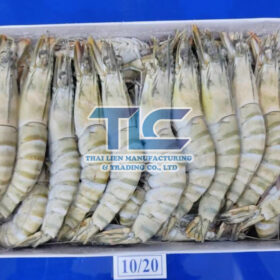Black Tiger Shrimp HOSO
Introduction
The Black Tiger Shrimp HOSO IQF, originating from the aquaculture-rich lands of Vietnam, has become a sought-after delicacy globally. As consumers increasingly explore diverse culinary experiences, this article delves into the nuances of this unique shrimp variety, covering its origin, characteristics, processing techniques, market dynamics, and more.
1. Vietnam: The Hub of Black Tiger Shrimp
Vietnam has emerged as a leading producer of Black Tiger Shrimp, thanks to its favorable climate and advanced aquaculture practices. The country’s coastal areas provide an ideal environment for cultivating these flavorful crustaceans.
2. Unveiling the Characteristics
Known for its distinctive characteristics, the Black Tiger Shrimp is easily identifiable by its larger size, dark stripes, and robust flavor. Its succulent meat and appealing appearance make it a favorite among seafood enthusiasts.
3. The Art of Processing: IQF Technology
The processing of Black Tiger Shrimp involves the ingenious use of IQF technology. Individually Quick Frozen ensures that each shrimp is frozen rapidly, preserving its freshness, taste, and nutritional value. This method also prevents the formation of ice crystals, maintaining the shrimp’s texture.
4. Global Demand and Market Trends
The demand for Black Tiger Shrimp HOSO IQF has witnessed a surge globally. As consumers lean towards healthier and more exotic dining choices, the market for this premium shrimp variety continues to grow. Restaurants and households alike are embracing the culinary possibilities it offers.
5. Quality Assurance with HOSO
Head-On Shell-On (HOSO) Black Tiger Shrimp is a mark of quality. Keeping the head and shell intact during processing ensures the shrimp’s natural flavor and texture are preserved, enhancing the overall culinary experience.
6. Health Benefits and Culinary Versatility
Beyond its delectable taste, Black Tiger Shrimp is rich in essential nutrients. Low in calories and high in protein, it’s a healthy addition to various diets. Its versatility in the kitchen allows for an array of dishes, from stir-fries to grills, satisfying different tastes.
7. Sustainable Shrimp Farming Practices
Addressing environmental concerns, the Black Tiger Shrimp industry in Vietnam is increasingly adopting sustainable farming practices. This includes responsible water usage, minimizing the use of chemicals, and ensuring the well-being of the surrounding ecosystems.
8. Challenges Faced by the Industry
While the industry thrives, challenges such as disease outbreaks and environmental impact persist. Striking a balance between meeting demand and maintaining sustainability is a continuous challenge for Black Tiger Shrimp farmers.
9. From the Sea to the Plate: Popular Recipes
Explore the culinary world of Black Tiger Shrimp with mouth-watering recipes. From classic shrimp scampi to innovative shrimp tacos, these recipes showcase the versatility and exquisite taste of this seafood delight.
10. Competitive Edge in the Shrimp Market
What sets Black Tiger Shrimp apart in a competitive market? Its size, distinctive appearance, and unique flavor contribute to its competitive edge. Discover why it stands out among other shrimp varieties.
11. Global Trading Patterns: Export and Import
Key players in the global shrimp market engage in the import and export of Black Tiger Shrimp. Understanding these trading patterns provides insights into the dynamics of the industry.
12. Consumer Tips: Selecting and Preparing
For those venturing into the world of Black Tiger Shrimp, understanding how to select and prepare it is crucial. From choosing the right size to cooking techniques, these tips ensure an enjoyable culinary experience.
13. Future Prospects of Black Tiger Shrimp
As the shrimp industry evolves, so do the prospects of Black Tiger Shrimp. Emerging trends hint at increased demand, innovations in processing, and a continued focus on sustainable practices.
14. Conclusion: The Significance of Black Tiger Shrimp HOSO IQF
In conclusion, the Black Tiger Shrimp HOSO IQF from Vietnam is more than a seafood delicacy; it’s a testament to the intersection of culinary excellence and sustainable practices. Its journey from the aquaculture farms to global plates represents the best of quality, flavor, and responsibility.
FAQs
- Is Black Tiger Shrimp HOSO IQF safe to consume raw?
- While some may enjoy it raw, it’s recommended to cook Black Tiger Shrimp thoroughly to eliminate any potential health risks.
- How can consumers ensure the quality of Black Tiger Shrimp?
- Opt for reputable suppliers, check for certifications, and choose HOSO for a guarantee of freshness.
- Are there any alternatives to Black Tiger Shrimp in the market?
- Yes, there are various shrimp varieties available, each with its own unique taste and characteristics.
- What makes Black Tiger Shrimp environmentally sustainable?
- Sustainable farming practices, minimal chemical usage, and responsible water management contribute to its environmental sustainability.
- Can I use Black Tiger Shrimp in any recipe that calls for shrimp?
- Absolutely! Its versatility makes it a perfect choice for a wide range of recipes.













I like the efforts you have put in this, regards for all the great content.